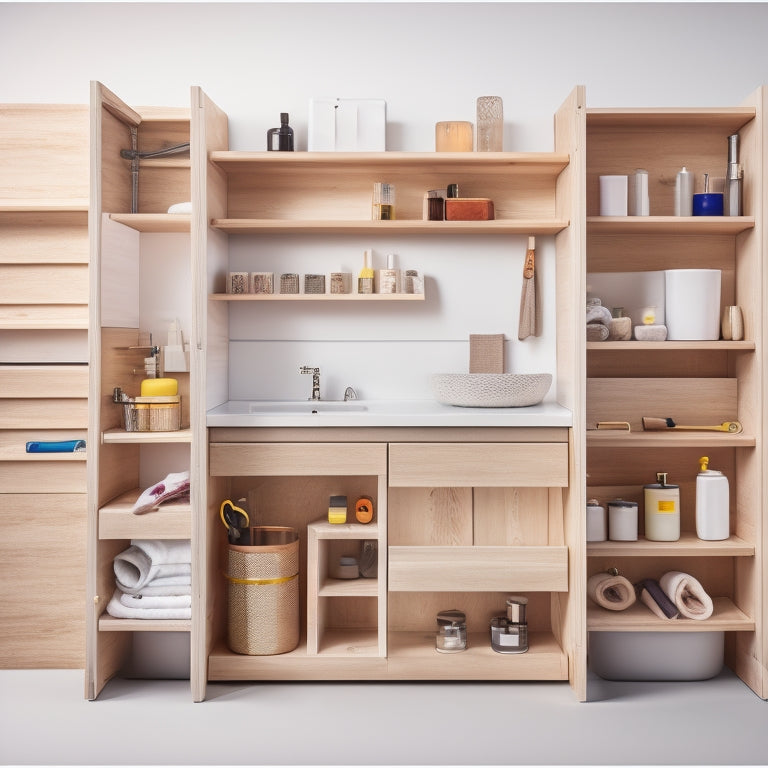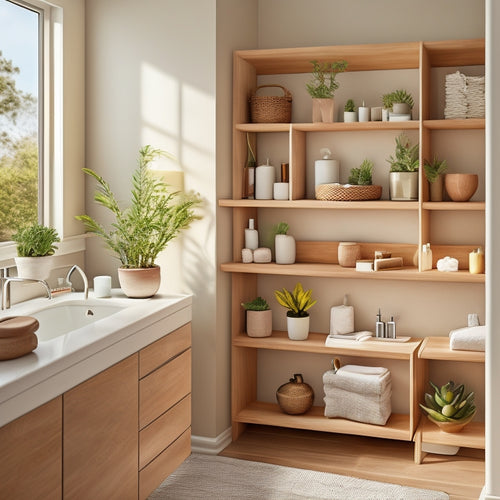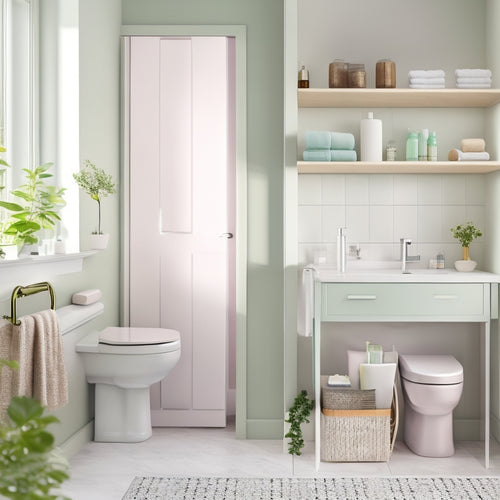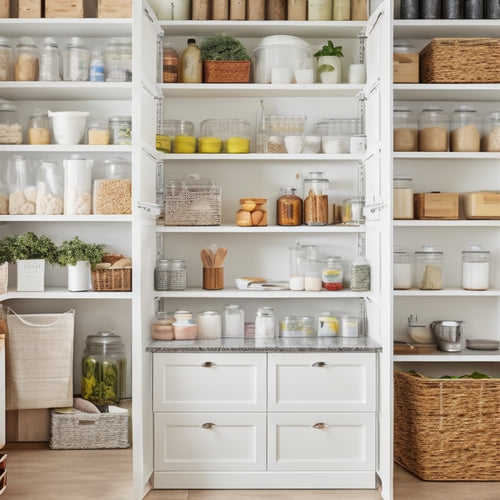
Build Your Own Bathroom Cabinets Made Easy in 7 Steps
Share
You're about to build your own bathroom cabinets in 7 easy steps! Start by planning your cabinet, evaluating your bathroom layout, and identifying your storage needs. Choose the right materials, considering durability, budget, and environmental impact. Next, construct the frame, assemble the cabinet box, and add shelving and supports. Then, install doors and handles, and finish with a water-resistant coat. Finally, install your cabinets, ensuring they're level and secure. With these steps, you'll be well on your way to creating custom cabinets that reflect your style and meet your needs - and you'll learn the details that'll make it a success.
Key Takeaways
- Assess your bathroom's layout and storage needs to determine the ideal cabinet design and material.
- Choose durable and moisture-resistant materials, considering budget, sustainability, and maintenance requirements.
- Measure and cut frame pieces precisely, using a combination square and practicing on scrap wood if needed.
- Assemble the cabinet box accurately, using clamps and wood screws, and attach a sturdy back panel for stability.
- Add shelves and supports, considering item size and storage needs, and install doors and handles that match your cabinet design.
Plan Your Bathroom Cabinet
Before you start shopping for a bathroom cabinet, take a closer look at your bathroom's layout and identify your storage needs.
Think about what you want to store and how you want to access it. Do you need a cabinet that fits snugly above the sink, or one that spans the entire wall? Make a list of the essentials you want to stash away, like toiletries, towels, and cleaning supplies.
Next, consider your design aesthetics. Do you prefer modern and sleek, or traditional and ornate?
Think about the style of your bathroom and how the cabinet will fit in. You want it to complement the space, not clash with it.
Measure your bathroom's dimensions and note any obstacles, like plumbing or electrical outlets.
Choose the Right Materials
What kind of material will best suit your bathroom cabinet needs? You've got a lot of options, and we're here to break them down for you.
When it comes to material types, you're looking at MDF, plywood, solid wood, or even reclaimed wood. Each has its own durability factors to evaluate, like moisture resistance and scratch resistance.
Your design style also comes into play - modern, traditional, or rustic? Set a budget and stick to it, because prices can vary wildly depending on the material and brand.
Don't forget to think about the environmental impact of your choice. Some materials are more sustainable than others, so if going green is important to you, choose wisely.
Maintenance tips will also influence your decision - some materials are a breeze to clean, while others require more TLC.
Finally, consider color options and texture choices. Do you want a bold, bright hue or a more subdued tone? A smooth finish or a rustic, distressed look?
Measure and Cut the Frames
With your materials chosen, you're ready to move on to the next essential step: measuring and cutting the frames for your bathroom cabinets. This is where precision matters, so take your time and double-check those measurements.
Determine the frame dimensions based on your cabinet design and the space available in your bathroom. Make certain to account for any obstructions, like plumbing or electrical outlets.
Use a combination square to guarantee your cuts are straight and accurate. For cutting, you can use a miter saw, circular saw, or even a jigsaw – whatever you're most comfortable with.
If you're new to cutting, consider practicing on scrap wood before moving to your actual frame pieces. Cutting techniques will vary depending on the type of saw you're using, so be certain to follow the manufacturer's instructions.
Take your time, and don't rush through this step. Remember, accurate cuts now mean fewer headaches later on.
Once you've cut all your frame pieces, you'll be ready to move on to the next step – assembling those cabinet boxes!
Assemble the Cabinet Boxes
You've successfully cut all your frame pieces, and now it's time to bring your cabinet boxes to life. This is the fun part – seeing your DIY project take shape! To assemble the cabinet boxes, start by attaching the sides to the top and bottom panels using wood screws and a drill. Be certain to align the pieces carefully and use clamps to hold them in place while you screw.
Essential Tools for Cabinet Assembly
| Tool | Purpose |
|---|---|
| Drill | Drive wood screws |
| Clamps | Hold pieces in place |
| Tape measure | Verify alignment |
Next, attach the back panel to the cabinet box using the same technique. Use cabinet assembly tips like applying even pressure and checking for square to guarantee a sturdy box. Finally, attach the shelves (but we'll get to that in the next step).
Remember to follow tool recommendations and take your time during the assembly process. With patience and attention to detail, you'll have your cabinet boxes built in no time!
Add Shelves and Back Panels
You'll need to take into account the spacing of your shelves to guarantee they accommodate the items you plan to store, such as towels, toiletries, or cleaning supplies.
Next, you'll choose the material for your back panels, which can range from simple plywood to decorative glass or mirrors.
Shelf Spacing Considerations
Several factors influence the ideal shelf spacing for your bathroom cabinet, including the size of items you plan to store, the type of shelves you're using, and your personal preference.
For instance, if you're planning to store large, heavy items like towels or cleaning supplies, you'll want to space your shelves farther apart to accommodate the weight and size. On the other hand, if you're storing smaller items like skincare products or toiletries, you can space them closer together.
Consider the shelf weight and shelf height when determining the ideal spacing. A good rule of thumb is to space your shelves 12-18 inches apart, but this can vary depending on your specific needs.
You'll also want to think about how often you'll be accessing the items on each shelf. If you need to grab something frequently, like toilet paper or toothbrushes, you may want to space the shelves closer together for easy access.
Back Panel Materials
Behind your bathroom cabinet's shelves, a sturdy back panel provides structural support and helps maintain the cabinet's integrity. You'll want to choose a material that's durable, resistant to moisture, and easy to work with. When it comes to back panel materials, you've got a few options to take into account.
Plywood is a popular choice, and for good reason. It's strong, affordable, and can be easily cut to size. You can opt for a thickness of 1/4 inch or 1/2 inch, depending on the design and weight capacity of your cabinet. Look for plywood options that are specifically designed for bathroom or kitchen use, as they'll be more resistant to moisture.
MDF (medium-density fiberboard) is another great option. It's denser than plywood, making it less prone to warping or shrinking. Plus, it's usually less expensive than plywood. The benefits of MDF include a smooth surface, making it ideal for painting or applying a laminate finish.
Just be sure to seal the edges to prevent moisture damage. Whichever material you choose, verify that it's properly attached to the cabinet frame to guarantee stability and longevity.
Adding Shelf Supports
Stability is key when it comes to your bathroom cabinet's shelves, and that's where shelf supports come in. You don't want your shelves sagging under the weight of your toiletries, do you? To guarantee your shelves stay put, you'll need to add support brackets.
There are various shelf types, such as fixed, adjustable, and floating shelves. Each type requires a specific support system. For fixed shelves, you'll need L-brackets or screw-in supports. Adjustable shelves require sliding supports that can be moved up or down. Floating shelves need hidden supports, like toggle bolts or hidden brackets, to maintain their sleek appearance.
When choosing support brackets, consider the weight capacity and material. Make certain the brackets are sturdy enough to hold the weight of your shelves and the items you'll be storing. You can opt for metal, plastic, or wooden brackets, depending on your cabinet's style and material.
Remember to space your support brackets evenly, usually 12-18 inches apart, to maintain stability and prevent sagging.
With the right shelf supports, your bathroom cabinet will be sturdy, functional, and looking fabulous!
Install Doors and Handles
Your bathroom cabinet's doors and handles are the final touches that bring functionality and style to the space.
Now it's time to choose from various door styles, such as raised panel, flat panel, or glass doors, to match your bathroom's aesthetic. Measure the cabinet openings to verify accurate door sizes. You can either build your own doors or purchase pre-made ones.
Next, attach the doors to the cabinet using hinges. Make sure they're aligned properly and the doors open smoothly.
For handle types, you have a wide range of options, from modern knobs to traditional pulls. Choose handles that complement your door style and bathroom decor. Install the handles according to the manufacturer's instructions, usually by screwing them into place.
Remember to test the doors and handles to verify they're secure and functional. Adjust the hinges or handles as needed to achieve a smooth, quiet operation.
With your doors and handles installed, you're one step closer to completing your bathroom cabinet project.
Finish and Install the Cabinets
Now that your doors and handles are securely in place, it's time to focus on finishing and installing the cabinets.
You've almost reached the finish line (pun intended)! For a professional-looking finish, apply a coat of primer and let it dry before adding your chosen color and finish. Consider using a water-resistant finish to protect your cabinets from moisture.
When it comes to installation, remember to measure twice and drill once. Confirm the cabinets are level and securely attached to the wall to prevent them from tipping over. Use shims to fill any gaps between the cabinets and the wall.
Don't be afraid to get creative with your installation – you can add decorative trim or molding to hide any gaps or imperfections.
Frequently Asked Questions
Can I Use MDF Instead of Plywood for the Cabinet Boxes?
You can use MDF instead of plywood for cabinet boxes, but consider the trade-offs: MDF's advantages include cost-effectiveness and smooth finish, while disadvantages like moisture sensitivity and density might make you rethink your decision, especially in a humid bathroom setting.
How Do I Prevent Warping of the Shelves Over Time?
You're wise to worry about warping shelves! Choose shelf materials with built-in moisture control, like water-resistant MDF or bamboo, and apply a waterproof coating to seal the deal - your shelves will stay straight and sturdy over time!
Are Soft-Close Hinges Necessary for Bathroom Cabinets?
You're wondering if soft-close hinges are a must-have for your bathroom cabinets - the answer is, they're the unsung heroes of cabinet hardware! They prevent slamming, reduce noise, and make hinge installation a breeze, so yeah, they're pretty darn necessary!
Can I Add Electrical Outlets Inside the Cabinets?
You're wondering if you can add electrical outlets inside your cabinets - the answer is yes, but don't get zapped! Guarantee circuit safety by consulting an electrician for proper outlet placement and wiring to avoid any shocking surprises.
Do I Need to Prime the Cabinets Before Painting?
You're about to get your paint on, but don't skip surface preparation! Yes, you need to prime those cabinets before painting - it's like dating, you want a strong bond to last.
Conclusion
You've nailed it! Your bathroom cabinets are now a stunning reflection of your DIY prowess. Like a skilled chef, you've mixed and matched the perfect blend of planning, materials, and skills to create a functional and stylish space. As you step back to admire your handiwork, the satisfaction of creating something with your own hands is the ultimate reward. Your bathroom's new look is sure to be the talk of the town, and you're the expert builder behind it all!
Related Posts
-

Space-Saving Bathroom Shelves With Open Design
Space-saving bathroom shelves with an open design can convert your compact space into a stylish sanctuary. By maximiz...
-

Wall-Mounted Bathroom Organizers for Small Spaces
Wall-mounted bathroom organizers are perfect for maximizing storage in small spaces. By utilizing vertical space, you...
-

Get Organized: Free Pantry Labels + More
I've learned the hard way that organization comes before labeling - a cluttered pantry with labels can actually look ...


